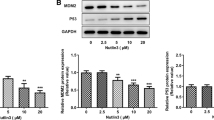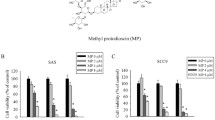Abstract
Human oral squamous cell carcinoma is the sixth most frequent malignant cancer, with an unacceptably high death rate that affects people's health. Albeit, there are several clinical approaches for diagnosing and treating oral cancer they are still far from ideal. We previously synthesised and characterised the docetaxel nanoformulation (PLGA-Dtx) and discovered that docetaxel nanoencapsulation may suppress oral cancer cells. The goal of this study was to figure out the mechanism involved in the suppression of oral cancer cell proliferation. We discovered that PLGA-Dtx inhibited SCC-9 cell growth considerably as compared to free docetaxel (Dtx), and that the viability of SCC-9 cells treated with PLGA-Dtx was decreased dose-dependently. MTT assay showed that PLGA-Dtx selectively inhibited the growth of PBMCs from oral cancer patients while sparing PBMCs from normal healthy controls. Further, flow cytometry analysis showed that PLGA-Dtx induced apoptosis and necroptosis in SCC-9 cells. G2/M cell cycle arrest has been confirmed on exposure of PLGA-Dtx for 24 h in SCC-9 cells. Interestingly, western blot investigation found that PLGA-Dtx increased the amounts of necroptic proteins and apoptosis-related proteins more efficiently than Dtx. Furthermore, PLGA-Dtx was more effective in terms of ROS generation, and mitochondrial membrane potential depletion. Pretreatment with necroptosis inhibitor Nec-1 efficiently reversed the ROS production and further recover MMP caused by PLGA-Dtx. Overall, this study revealed a mechanistic model of therapeutic response for PLGA-Dtx in SCC-9 cells and proposed its potency by inducing cell death via activation of concurrent apoptosis and necroptosis in SCC-9 cells via TNF-α/RIP1/RIP3 and caspase-dependent pathway.





Similar content being viewed by others
Availability of Data and Material
Not applicable.
Code Availability
Not applicable.
References
Sung H, Ferlay J, Siegel RL, Laversanne M, Soerjomataram I, Jemal A, et al. Global cancer statistics 2020: GLOBOCAN estimates of incidence and mortality worldwide for 36 cancers in 185 countries. CA Cancer J Clin. 2021;71:209–49.
Rivera C. Essentials of oral cancer. Int J Clin Exp Pathol. 2015;8:11884.
Zhou J, Kang Y, Chen L, Wang H, Liu J, Zeng S, et al. The drug-resistance mechanisms of five platinum-based antitumor agents. Front Pharmacol. 2020;11:343.
Ketabat F, Pundir M, Mohabatpour F, Lobanova L, Koutsopoulos S, Hadjiiski L, et al. Controlled drug delivery systems for oral cancer treatment—current status and future perspectives. Pharmaceutics. 2019;11:302.
Mohammad RM, Muqbil I, Lowe L, Yedjou C, Hsu HY, Lin LT, et al. Broad targeting of resistance to apoptosis in cancer. Semin Cancer Biol. 2015;35:S78-103.
Patra JK, Das G, Fraceto LF, Campos EVR, Rodriguez-Torres MDP, Acosta-Torres LS, et al. Nano based drug delivery systems: recent developments and future prospects. J Nanobiotechnol. 2018;16:71.
Zeng Q, Ma X, Song Y, Chen Q, Jiao Q, Zhou L. Targeting regulated cell death in tumor nanomedicines. Theranostics. 2022;12:817.
Sonkusre P, Cameotra SS. Biogenic selenium nanoparticles induce ROS-mediated necroptosis in PC-3 cancer cells through TNF activation. J Nanobiotechnol. 2017;15:43.
Sanpui P, Chattopadhyay A, Ghosh SS. Induction of apoptosis in cancer cells at low silver nanoparticle concentrations using chitosan nanocarrier. ACS Appl Mater Interfaces. 2011;3:218–28.
Nehmé A, Varadarajan P, Sellakumar G, Gerhold M, Niedner H, Zhang Q, et al. Modulation of docetaxel-induced apoptosis and cell cycle arrest by all-trans retinoic acid in prostate cancer cells. Br J Cancer. 2001;84:1571–6.
Wong RSY. Apoptosis in cancer: from pathogenesis to treatment. J Exp Clin Cancer Res. 2011;30:1–14. https://doi.org/10.1186/1756-9966-30-87.
Green DR, Llambi F. Cell Death Signaling. Cold Spring Harb Perspect Biol. 2015;7. Available from: /pmc/articles/PMC4665079/
Vanden BT, Linkermann A, Jouan-Lanhouet S, Walczak H, Vandenabeele P. Regulated necrosis: the expanding network of non-apoptotic cell death pathways. Nat Rev Mol Cell Biol. 2014;15:135–47.
Tang D, Kang R, Vanden BT, Vandenabeele P, Kroemer G. The molecular machinery of regulated cell death. Cell Res. 2019;29(5):347–64.
Gupta P, Singh M, Kumar R, Belz J, Shanker R, Dwivedi PD, et al. Synthesis and in vitro studies of PLGA-DTX nanoconjugate as potential drug delivery vehicle for oral cancer. Int J Nanomed. 2018;13:67.
Hernández-Vargas H, Palacios J, Moreno-Bueno G. Molecular profiling of docetaxel cytotoxicity in breast cancer cells: uncoupling of aberrant mitosis and apoptosis. Oncogene. 2007;26:2902–13.
Mediavilla-Varela M, Pacheco FJ, Almaguel F, Perez J, Sahakian E, Daniels TR, et al. Docetaxel-induced prostate cancer cell death involves concomitant activation of caspase and lysosomal pathways and is attenuated by LEDGF/p75. Mol Cancer. 2009;8:68.
Wu YT, Tan HL, Huang Q, Sun XJ, Zhu X, Shen HM. zVAD-induced necroptosis in L929 cells depends on autocrine production of TNFα mediated by the PKC–MAPKs–AP-1 pathway. Cell Death Differ. 2011;18(1):26–37.
Dhuriya YK, Sharma D. Necroptosis: a regulated inflammatory mode of cell death. J Neuroinflammation. 2018;15(1):1–9. https://doi.org/10.1186/s12974-018-1235-0.
Chen D, Yu J, Zhang L. Necroptosis: an alternative cell death program defending against cancer. Biochim Biophys Acta. 2016;1865:228.
Antonarakis ES, Armstrong AJ. Evolving standards in the treatment of docetaxel-refractory castration-resistant prostate cancer. Prostate Cancer Prostatic Dis. 2011;14(3):192–205.
Da Rocha MCO, Da Silva PB, Radicchi MA, Andrade BYG, De Oliveira JV, Venus T, et al. Docetaxel-loaded solid lipid nanoparticles prevent tumor growth and lung metastasis of 4T1 murine mammary carcinoma cells. J Nanobiotechnol. 2020;18:1–20. https://doi.org/10.1186/s12951-020-00604-7.
Yuan Q, Han J, Cong W, Ge Y, Ma D, Dai Z, et al. Docetaxel-loaded solid lipid nanoparticles suppress breast cancer cells growth with reduced myelosuppression toxicity. Int J Nanomed. 2014;9:4829.
Yuan SJ, Xu YH, Wang C, An HC, Xu HZ, Li K, et al. Doxorubicin-polyglycerol-nanodiamond conjugate is a cytostatic agent that evades chemoresistance and reverses cancer-induced immunosuppression in triple-negative breast cancer. J Nanobiotechnology. 2019;17:110.
Srivastava A, Amreddy N, Babu A, Panneerselvam J, Mehta M, Muralidharan R, et al. Nanosomes carrying doxorubicin exhibit potent anticancer activity against human lung cancer cells. Sci Rep. 2016;6(1):1–15.
Mann J, Yang N, Montpetit R, Kirschenman R, Lemieux H, Goping IS. BAD sensitizes breast cancer cells to docetaxel with increased mitotic arrest and necroptosis. Sci Rep 2020;10. Available from: /pmc/articles/PMC6962214/
Lee GY, Mubasher M, Mckenzie TS, Schmitt NC, Sebelik ME, Flanagan CE, et al. Assessment of a nano-docetaxel combined treatment for head and neck cancer. Onco. 2021;1:83–94.
Feng X, Xiong X, Ma S. Docetaxel-loaded novel nano-platform for synergistic therapy of non-small cell lung cancer. Front Pharmacol. 2022;13:230.
Liu Y, Liu T, Lei T, Zhang D, Du S, Girani L, et al. RIP1/RIP3-regulated necroptosis as a target for multifaceted disease therapy (Review). Int J Mol Med. 2019;44:771.
Kaokaen P, Chaicharoenaudomrung N, Kunhorm P, Mesil K, Binlateh T, Noisa P, et al. Nanoencapsulation of cordycepin induces switching from necroptosis to apoptosis in human oral cancer cells (HSC-4) through inhibition of receptor-interacting serine/threonine-protein kinase 3 (RIPK3) and autophagy modulation. Natural Product Commun. 2022. https://doi.org/10.1177/1934578X221074838.
Wilhelmi V, Fischer U, Weighardt H, Schulze-Osthoff K, Nickel C, Stahlmecke B, et al. Zinc oxide nanoparticles induce necrosis and apoptosis in macrophages in a p47phox- and Nrf2-independent manner. PLoS ONE. 2013;8:e65704. https://doi.org/10.1371/journal.pone.0065704.
Perillo B, Di Donato M, Pezone A, Di Zazzo E, Giovannelli P, Galasso G, et al. ROS in cancer therapy: the bright side of the moon. Exp Mol Med. 2020;52(2):192–203.
Reczek CR, Chandel NS. The two faces of reactive oxygen species in cancer. Annu Rev Cancer Biol. 2017;1:79–98.
Xian D, Lai R, Song J, Xiong X, Zhong J. Emerging Perspective: Role of Increased ROS and Redox Imbalance in Skin Carcinogenesis. Oxid Med Cell Longev 2019;2019. Available from: /pmc/articles/PMC6766104/
Zorov DB, Juhaszova M, Sollott SJ. Mitochondrial reactive oxygen species (ROS) and ROS-induced ROS release. Physiol Rev. 2014;94:909.
Lu B, Gong X, Wang ZQ, Ding Y, Wang C, Luo TF, et al. Shikonin induces glioma cell necroptosis in vitro by ROS overproduction and promoting RIP1/RIP3 necrosome formation. Acta Pharmacol Sin. 2017;38(11):1543–53.
Schenk B, Fulda S. Reactive oxygen species regulate Smac mimetic/TNFα-induced necroptotic signaling and cell death. Oncogene. 2015;34(47):5796–806.
Morgan MJ, Liu ZG. Reactive oxygen species in TNFα-induced signaling and cell death. Mol Cells. 2010;30:1.
Sun W, Wu X, Gao H, Yu J, Zhao W, Lu JJ, et al. Cytosolic calcium mediates RIP1/RIP3 complex-dependent necroptosis through JNK activation and mitochondrial ROS production in human colon cancer cells. Free Radic Biol Med Pergamon. 2017;108:433–44.
Acknowledgements
We are sincerely thankful to Dr. P. D. Dwivedi, Retired Senior Principal Scientist, CSIR-Indian Institute of Toxicology Research,Lucknow for providing guidance and facility for laboratory experiments.
Funding
This work was supported by Council of Scientific & Industrial Research (CSIR), India [No. 31/29(262)/2017-EMR-I, Fellowship to PG].
Author information
Authors and Affiliations
Contributions
Conceptualization: PG, AKV. Data analysis: PG, AKV, AKP, AS, PK. Funding: PG. Investigation: PG, AKV, AS, AKP, SK, PK,VP. Experimental studies: PG, VK, AKP, AM, AKV. Validation: PG, AKV, AKP, AS, AM, PK, VP. Manuscript writing & original draft: PG, AKP, AKV, AS. Writing, review & editing: PG, AKV, AS, AKP, SK, AM, VK, VP.
Corresponding author
Ethics declarations
Conflict of interest
Authors declare no competing interest.
Ethics Approval
Study protocol was approved by Institutional Ethics Committee of the institution. Additionally, study was performed in accordance of approved protocol.
Consent to Participate
Informed written consent was taken from all the participants prior to enrolling in the study.
Consent for Publication
Written consent was obtained from all the persons prior to publication.
Additional information
Publisher's Note
Springer Nature remains neutral with regard to jurisdictional claims in published maps and institutional affiliations.
Rights and permissions
Springer Nature or its licensor holds exclusive rights to this article under a publishing agreement with the author(s) or other rightsholder(s); author self-archiving of the accepted manuscript version of this article is solely governed by the terms of such publishing agreement and applicable law.
About this article
Cite this article
Gupta, P., Singh, A., Verma, A.K. et al. Nanoencapsulation of Docetaxel Induces Concurrent Apoptosis and Necroptosis in Human Oral Cancer Cells (SCC-9) via TNF-α/RIP1/RIP3 Pathway. Ind J Clin Biochem 38, 351–360 (2023). https://doi.org/10.1007/s12291-022-01055-7
Received:
Accepted:
Published:
Issue Date:
DOI: https://doi.org/10.1007/s12291-022-01055-7




